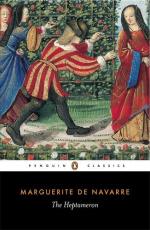1 Oraison funebre, &c., p. 103.
2 Sainte-Marthe states
that she would sit with two
secretaries, one on
either side, and dictate poetry to the
one and letters to the
other.
Margaret’s daughter Jane was at this period at the Court of France, living in extravagant style, as is shown by the letters in which Margaret declares that the Princess’s expenditure is insupportable. She herself spent but little money upon personal needs, though she devoted considerable sums to charity. In October 1548 she emerged from her seclusion to attend the second marriage of her daughter, who now became the wife of Anthony de Bourbon, Duke of Vendome. From Moulins, where the ceremony took place, Margaret repaired to the Court at Fontainebleau. Here all was changed: there was a new King, and Diana of Poitiers occupied the position of the Duchess of Etampes. After returning to Beam for Christmas, Margaret spent the Lent of 1549 in retreat at Tusson, where she apparently divided her time between prayer and literary labour. She was still writing the Heptameron, as is shown by the sixty-sixth tale, which chronicles an adventure that befell her daughter and Anthony de Bourbon on their marriage trip during the winter of 1548-49. It may be noted, too, that the scene of the sixty-ninth story is laid at the Castle of Odos near Tarbes, and as Margaret came to reside at the castle in the autumn of 1549, this tale was probably written during her sojourn there. Whilst adding fresh stories to the Heptameron, she was not neglecting poetry, for from this period also dates the Miroir de Jesus Christ crucifie, which Brother Olivier published in 1556, stating that it was the Queen’s last work, and that she had handed it to him a few days before her death.
Margaret had long been in failing health and was growing extremely weak. Brantome, on the authority of his grandmother, states that when her approaching death was announced to her, she found the monition a very bitter one, saying that she was not yet so aged but that she might live some years longer. She was then in her fifty-eighth year. Sainte-Marthe relates that shortly before her death she saw in a dream a very beautiful woman holding in her hand a crown of all sorts of flowers which she showed to her, telling her that she would soon be crowned with it.(1)
1 Oraison funebre, &c., p. 104.
She interpreted this dream as signifying that her end was near, and from that day forward abandoned the administration of her property to the King of Navarre, refusing to occupy herself with any other matter than that of her approaching end. After dictating her will she fell into her final illness, which lasted twenty days according to some authorities, and eight according to others. It seized her one night at Odos whilst she was watching a comet, which it was averred had appeared to notify the death of Pope Paul III. “It was perhaps to presage her own,” naively remarks Brantome, who adds that while she was looking at the comet her mouth suddenly became partially paralysed, whereupon her doctor, M. d’Escuranis, led her away and made her go to bed. Her death took place on December 21st, 1549, and just before expiring she grasped a crucifix that lay beside her and murmured, “Jesus, Jesus, Jesus.” (1)




